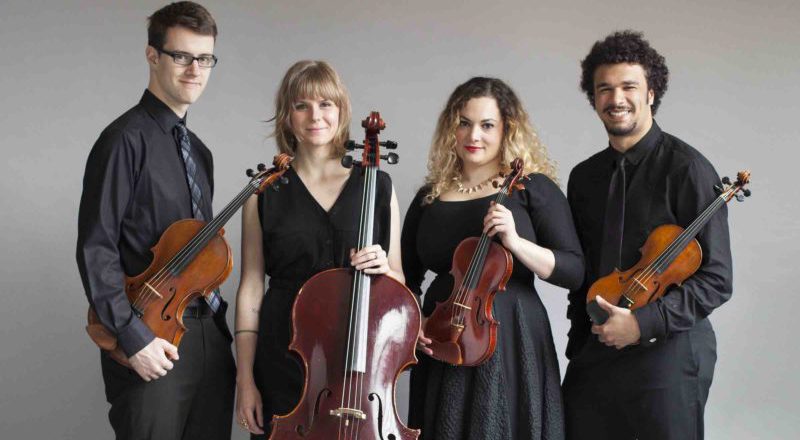INTERVIEW: Learn chamber music without leaving the house
Photo: PUBLIQuartet features, from left, Nick Revel, Amanda Gookin, Jannina Norpoth and Curtis Stewart. Photo courtesy of Ryan Scherb / Provided by artist press kit at Concert Artists Guild.
The Associated Chamber Music Players’ mission is to spread the wonders and possibilities of chamber music to players around the world. To help them achieve that goal, the group will live stream a masterclass on chamber music Saturday, Feb. 10 at 2:30 p.m. The event, featuring the world-renowned PUBLIQuartet, will broadcast from the National Opera Center, but students and musicians can enjoy the lessons from the comforts of their own abode.
The free event will feature multiple camera angles and include lessons on technique and interpretation. Two pieces will be intimately explored: Astor Piazzolla’s Oblivion and Sergei Prokofiev’s String Quartet No. 2, movement 2.
PUBLIQuartet, a well-known group of musicians that have played venues around the world, will help guide the lesson and finish the program with a performance of Piazzolla’s Libertango, a selection from Meredith Monk’s Stringsongs and Jessie Montgomery’s Voodoo Dolls.
Recently, Hollywood Soapbox exchanged emails with Nick Revel, founding violist of PUBLIQuartet. Questions and answers have been slightly edited for style.
What can students expect during the masterclass?
Students in regular chamber music coachings often focus on the fundamentals of putting together a piece of music without a conductor: pulse, rhythm, listening, pitch and dynamics. In our upcoming masterclass, they can expect us to take their preparation and focus it into a deeper level of musicality, one that involves emotions, phrasing, mood, style and pacing.
How difficult is it to learn this chamber music?
Chamber music can be difficult for musicians of any level depending on the rhythmic complexity of the music. The hardest and most crucial skill is to maintain a singular group-pulse that grounds all the musicians into the same time-feel allowing them to play their rhythms in sync with each other. Doing so requires a huge amount of situational awareness, being able to play your own part while simultaneously listening and noticing what others are playing. Even when a group is fully in-sync, one also has to correctly interpret the others’ rhythms so as not mistake someone’s upbeat for a downbeat.
What do you like and find challenging about Astor Piazzolla’s Oblivion?
I have never played this piece, but I have played the music of Piazzolla and am familiar with his style of playing and writing. He’s unique as a composer, drawing connections between multiple genres of music; he wrote in the tradition of tango, influenced by jazz harmony, and structured into classical forms. Playing Piazzolla is not at all like playing [Wolfgang Amadeus] Mozart, and often times we instinctually play with a ‘classical’ sound, which in my opinion is not messy, edgy or gritty enough to play tango.
What are the plans for the live stream after Feb. 10?
We’ve been building our education packages for many years now. Education is a crucial part of our mission, especially when it comes to playing outside the box, expressing through improvisation and teaching how to write music. We will likely keep the video for ourselves and use it as a promotional tool for presenters and institutions to to continue to grow our education platform.
By John Soltes / Publisher / John@HollywoodSoapbox.com
Associated Chamber Music Players and PUBLIQuartet will offer a live-stream masterclass on chamber music Saturday, Feb. 10 at 2:30 p.m. Click here for more information.

